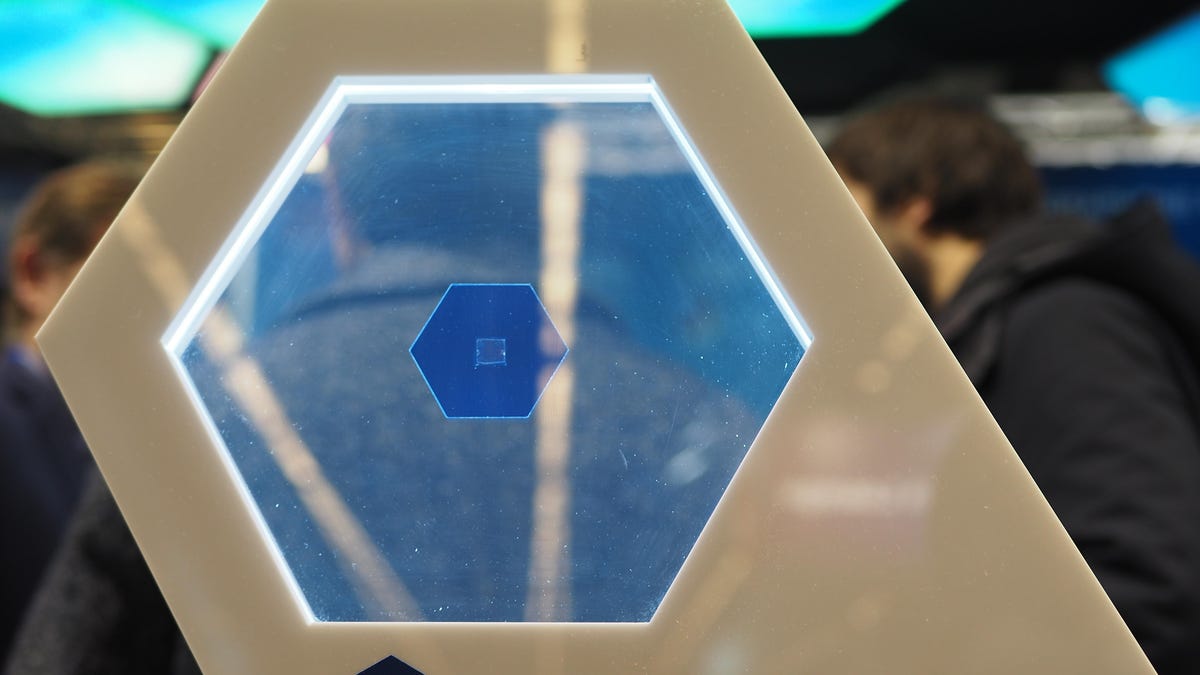Graphene could charge your phone in 7 seconds
Graphene gets touted as a “wonder material” because of its unique properties. Here are five potential real-world uses.

Graphene is 200 times stronger than steel and lighter than paper and often referred to as a wonder material. But what can this substance actually do?
Fortunately, graphene had a chance to shine at last month's Mobile World Congress trade show in Barcelona. Buried away at the furthest point from the entrance to the convention center was the Graphene Pavilion, where around 25 different graphene-based research projects, including robotics and wearables, were being shown off.
In the coming years some of these applications will go commercial and we'll start to see graphene cropping up in phones, wearables and other technology.
Graphene is a thin layer of pure carbon atoms tightly packed in a honeycomb structure. It isn't manufactured, but instead is extracted from graphite -- a process scientists only succeeded in developing in 2004. The result is a 2D substance that has a number of unusual and desirable traits, including being extraordinarily thin, strong and flexible.
A graphene insole can be so thin as to make no discernible difference to a shoe wearer.
Europe is where graphene was first isolated, and so convinced is the EU by its potential that it's the basis of the bloc's biggest research initiative. The billion-euro Graphene Flagship program, which hosted the Graphene Pavilion, is dedicated to finding ways in which the material can be brought to market.
Here's how graphene may be used in the future.
Smartphones
Graphene may have been hidden away at the back of the show this time around, but in the coming years it could be responsible for some dramatic upgrades to phone technology. As well as being flexible enough to be incorporated into bendable phones in the form of antennas or touch displays, it also has enormous potential for improving batteries -- often our biggest gripe when it comes to our phones.
Graphene can be built into the batteries themselves to improve energy storage and long-term performance, but it can also speed up energy transfer between a power source and battery exponentially. It acts as a sort of superhighway for charging, allowing energy to pass through it so quickly that researchers believe it can charge a phone in 7 seconds.
So how long will this seemingly magical technology take to show up? A decade? Kari Hjelt, head of innovation for Graphene Flagship, said it would take as little as two years.
"It's still a young material, so we're actually quite amazed how much it has developed in only 14 years," he said. "The thing with the graphene is that it works in so many fields and in fantastic ways, so we have really pick the ones that are the most promising for Europe and for business."
Phone technology is one obvious use, and 5G network tech is another -- Ericsson used graphene in its own 5G demo at the show. But it's not the only area where the material can make a difference.
Robotics
One biomedical possibility for graphene is in the improvement of artificial limbs.
By embedding graphene-based nerve sensors within the top of the limbs, a person is able to sense and respond to contractions and other movements in muscles. That helps them control the motion and force of a robotic limb.
Artificial limbs have come a long way in recent years, but they could get even lighter and more responsive still.
As well as being light and noninvasive, graphene responds quickly to pressure, ensuring natural movement and grip for the wearer. It could make future generations of prosthetics more comfortable and responsive than ever before.
Food identification
Due to graphene's ability to absorb light at almost every wavelength, it can detect ultraviolet, visible and infrared light with the same image sensor.
A wide-spectrum graphene light camera can see details invisible to the human eye, and in the demo we saw could differentiate between three different types of milk -- rice, dairy and almond -- that all look the same.
Graphene could improve food safety.
In the future people, with food allergies could use their phone cameras to tell if food is safe for them to eat.
Wearable tech
Graphene is also very flexible, making it ideal for wearable technology. Researchers from the the Institute of Photonic Sciences in Spain have integrated graphene into UV patches attached to the skin like any Band-Aid might. The layer of graphene hidden inside is highly sensitive and can measure heart rate and blood oxygen over skin as well as UV exposure, providing a miniaturized system that can monitor your health.
Graphene can be embedded in stick-on UV sensors.
Graphene could also be added to smart shoes for benefits including sensing, cooling and strength. A graphene in-sole from the University of Cambridge can monitor pressure distribution for podiatry and athletic performance.
New touch interfaces
Layers of graphene are so thin, they're almost invisible to the human eye. At the Graphene Pavilion we saw it built into a seemingly transparent screen and used to control a toy car by touch. It's just one example of how touch interfaces of the future could be built into different materials like glass or fabric.
Graphene could make new touch interfaces possible.
"The possibilities of this material seem endless," said EU Commissioner Andrus Ansip in a blog post after visiting the pavilion. "I was particularly struck by how practical they are and how well geared towards the consumer."
Blockchain Decoded: CNET looks at the tech powering bitcoin -- and soon, too, a myriad of services that will change your life.
Tech Culture: From film and television to social media and games, here's your place for the lighter side of tech.

